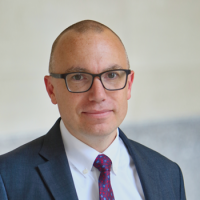Rethinking Humanitarian Aid
The world faces terrible suffering brought on by natural and man-made disasters, and humanitarian aid plays a critical role in saving lives and preserving stability. Humanitarian aid can even be understood as a necessary expression of global responsibility. Nevertheless, like any investment or aid program, this assistance is not without its pitfalls and blind spots. We cannot ignore or look away from these challenges and moral hazards simply because of the noble humanitarian mission; in some cases, humanitarian aid does more harm than good.
This event brought together experts and practitioners to explore some of the challenges facing the humanitarian-aid community, and potential measures to ensure aid is more effective for its beneficiaries.
Key Takeaways
- In the last two decades, the humanitarian aid sector has undergone tremendous growth in terms of its activities and funding. This has compelled the sector to become more professionalized and bureaucratized, which, in turn, limits its adaptability to different contexts and emerging challenges.
- Experts in the humanitarian aid sector agree that locals from beneficiary countries are central to the design and implementation of humanitarian aid. However, what role these local actors take up in practice is up for debate. Locally-led initiatives can shoulder a burden of risk on nationals or they can funnel resources to adversarial groups.
- The private sector can play a complementary role to humanitarian efforts by strengthening markets in the beneficiary countries. This can reduce the risk of donor dependency and raise the living standards of communities in need.
Selected Quotes
Jessica Alexander, Policy Editor, The New Humanitarian; Faculty, School of International and Public Affairs, Columbia University
“The two main events, obviously, that happened in 2020, which became this fascinating time to rethink the humanitarian sector were, of course, the pandemic and the Black Lives Matter movement. This wasn't the first time that the aid system had reformed or thought about reform. The humanitarian history is littered with efforts in doing so and usually in reaction to a revealed bad practice after a major crisis. The sector runs around scrambling to correct itself with new policies and technical fixes. It’s not therefore that the sector is resistant to change, but many argue that they go about changing the wrong things.”
“This idea that frontline or local actors don’t have enough capacity though to meet the needs, I mean that was really exposed as a false assumption. They stepped up as they always do and showed extreme solidarity with their communities. At the same time, the Black Lives Matter movement forced this reckoning with these power imbalances and social injustice, of course. And the aid sector itself is premised on opposing this kind of injustice and it’s grappled with how these questions present racism within the sector; the colonial roots of humanitarianism, and continued colonial practices of this very western dominated model and what are the implications of that.”
“We can’t just keep coming back in after every crisis and there needs to be sort of these joint outcomes that we both planned for together. So if we are in a food-insecure environment, well the humanitarians are going to provide for the acute malnutrition. But there is a longer-term goal that development actors are trying to address that, you know, meet the needs [of] some of the systemic issues about food insecurity so that humanitarians don’t have to be on this constant treadmill of trying to provide support in a context that really needs longer-term development and investment.”
"Oftentimes humanitarians may come in immediately after a crisis, but they stay for a long time and that’s because there isn’t development assistance to meet the needs of vulnerable people. And so humanitarians are really left holding the bag when it comes to providing life-saving support that, if there was more investment in development, could be avoided. And so, these initiatives every couple of years to ensure linkages is really to say, ‘This is ludicrous. We can’t keep coming back in after every crisis.” And there needs to be these joint outcomes that we both plan for together. So, if we’re in a food insecure environment, well the humanitarians are going to provide for acute malnutrition, but there is a longer-term goal that development actors are trying to address that meets the needs of some of the systemic issues about food insecurity."
William Steiger, Public Policy Fellow; Former Chief of Staff at USAID
“You are right to use the word industry, I would go farther than that and say it’s an oligopoly…A phrase economists would use to describe humanitarian assistance is a closed market. It is composed of a relatively small number of mostly UN agencies and international NGOs and the system itself makes it very difficult for new entrants to break into this business. Aid is delivered basically on the idea that we have to trust those who worked with us in the past and there is a huge aversion among donors, including USAID, to risk untested approaches. And it means that we give large amounts of money to organizations whether they are the most efficient or effective providers or not.”
“We are naive to believe that there is not a political aspect to humanitarian assistance. In every situation, politics has to be considered. I think even after much resistance, USAID has recognized that there is no such thing as impartially delivered or completely impartially delivered foreign aid. There are choices to be made and unfortunately, in some circumstances, it is probably the case that our aid is making situations worse and that there is a moral hazard to some of our humanitarian assistance because of the political aspects. The worst regimes are skillful at manipulating humanitarian assistance in their favor either for their political benefit, their public relations benefit, or for their financial benefit.”
“The humanitarian need, or potential need, in Afghanistan is undeniable but I hope that the U.S. government and all of the other donors are thinking through very carefully how to avoid some of the pitfalls that we saw in Yemen that Asher has very accurately described in his article and his research. The potential for theft, for diversion, for funding terrorism is extraordinarily high in Afghanistan. The urge to meet needs no matter [the] cost needs to be tempered with the recognition that safeguards like vetting and thorough guardrails need to be put in place that would restrict the Taliban from profiting from any assistance.
The phrase that economists would use to describe humanitarian assistance is “a closed market.” It is composed of a relatively small number of mostly UN agencies, and international NGOs, and the system itself makes it very difficult for new entrants to break into this business. And aid is delivered on the idea that we have to trust those we’ve worked with in the past, and there is a huge aversion among donors, including USAID, to risk untested approaches. And it means we give large amounts of money to organizations, whether they are the most efficient or effective providers or not."
Asher Orkaby, Research Scholar, Transregional Institute, Princeton University
“Between around 2015 and 2019, Yemen received upwards of fifteen billion dollars in humanitarian aid. Its highest annual total in 2018, that number reached 5.2 billion, and to put that in perspective that is about fifteen percent of Yemen's prewar GDP. So overnight, humanitarian aid has become one of the country's largest economic sectors and it serves as a disincentive for [a] peaceful resolution to the conflict, at least by those who are profiting the most from the sector. That includes local political actors and militants, many of whom have come on to serve as the default partners for large-scale humanitarian aid delivery.”
“The increasing amounts of unchecked foreign aid has really created a very unhealthy donor dependency. And donor dependency is something that has occurred not just in Yemen but throughout the conflicts that we will be focusing on today and where humanitarian aid primarily focuses on. Where short-term solutions are really hampering long-term developmental prospects. It’s creating a cycle that one can hardly break out of.”
“The two main challenges to localization are really the fact that local, even regional, organizations are precisely that and there's a capacity for small scale solutions that are even able to source food aid for instance locally. But it's far more difficult to scale up nationally, especially when existing civil society organizations on the ground are divided by local affiliation and oftentimes tribal and religious identity. Lastly, there is an inherent danger of humanitarian aid being used to build political patronage networks, so therefore there always needs to be that disinterested intermediary to administer the funds, otherwise, these funds end up becoming just another way to bribe and incentivize local officials.”
"How could one possibly solve this cycle of donor dependency and this cycle of very negative relationship to humanitarian aid in the long-term? So, part of the solution could be the localization of humanitarian aid. Certainly, this was the case in Yemen during the 80s and 90s. Very successful local development associations and the potential to rely maybe more on national partners has the potential to increase the efficiency of aid programs [and] lessen donor dependency. And most importantly, avoid the bloated and expensive bureaucracies of international NGOs, which often are the majority of the costs. But it’s not a magic bullet. There are still two main challenges to localization: local, and even regional, organizations are precisely that. There is a capacity for small-scale solutions that even are able to source food aid, for instance, locally. But it’s far more difficult to scale up nationally, especially when existing civil society organizations on the ground are divided by local affiliation and oftentimes tribal and religious identity. And lastly, there is an inherent danger of humanitarian aid being used to build political patronage networks. So there always needs to be a disinterested intermediary to administer funds, otherwise, these funds end up becoming just another way to bribe and incentivize local officials."
Hallam Ferguson, Public Policy Fellow; Former Senior Deputy Assistant Administrator, USAID
“To put the problem of humanitarian aid and humanitarian need into context, according to UNHCR (United Nations High Commissioner for Refugees), as of the end of 2020, there were about 82.4 million people displaced around the world, which is the most on record. That is four times more than it was in 1995. This is a problem that has been increasing significantly over just the last couple of decades.”
“One thing that really continues to strike me is just the magnitude of the need and the sheer number of people who are displaced today is so much greater than it was in the mid-1990s when the humanitarian industry, or sector, or oligopoly if you will, was first getting started in its modern form. Not just in sheer numbers but proportionally. The global population has increased over the last two decades but not nearly to the extent that the number of people who are displaced has increased.”
"According to the UNHCR, as of the end of 2020, there were about 82.4 million people displaced around the world, which is the most on record. That is four times more than it was in 1995. And so, this is a problem that has been increasing significantly over just the last couple of decades. Now, humanitarian assistance has kept pace, largely. It is approximately four times the size it was in the mid 1990s. Now, to remind everyone, of course, the mid-1990s weren’t exactly a great time. Bosnia was in a terrible crisis, Rwanda, Somalia. And yet, we’re in a place today where people in need, and the funding requirements to sustain them, has quadrupled. And so that is the context for what we’re talking about today."
Event Summary
The humanitarian aid community faces critical challenges that undermine its effectiveness, in some cases harming beneficiary communities more than it helps. Today, there are approximately 82.4 million displaced people globally, and the amount of need for humanitarian aid has quadrupled since the 1990s. The humanitarian aid sector must reckon with its historical shortcomings to meet rising demand and improve outcomes for recipient countries.
The Challenge of Reform
Changes in the humanitarian aid community often prioritize technocratic tweaks over comprehensive reform. Jessica Alexander explained aid organizations fall short of addressing root causes: “It’s not that the sector is resistant to change, but many argue that they go about changing the wrong things.” For example, USAID continues to distribute large amounts of money to the same organizations, in part because of its rigid assessment process. William Steiger argued that coordinating with other countries’ aid agencies will avoid duplicative efforts and broaden its network of organizations. He also suggested, “The kind of awards that USAID should be making should be smaller and with less strings attached.”
The Negative Side of Aid
Prolonged humanitarian aid risks donor dependency and hampers the growth of local markets. Asher Orkaby explained, “Food aid has brought Yemeni farmers into a ruinous cycle of poverty. Farmers cannot compete with free or subsidized food, and then have no profits to invest during cropping season.” This leads to a heightened response from the World Food Program and the cycle continues.
The distribution of humanitarian aid is subject to politicization in both the donor and beneficiary countries. Granting aid to the wrong party can funnel resources to adversarial groups and, especially in conflict zones, disincentivize political leaders from reaching a resolution. The allocation of government funds for humanitarian purposes may generate discontent domestically, as well. Steiger argued, “We are naïve to believe there is not a political aspect to humanitarian aid. There is no such thing as completely impartial foreign aid.”
A Path to More Effective Humanitarian Aid
The private sector has played an increasingly more important role in humanitarian efforts. While private sector entities are not able to match the amount of public funding, they help fuel local markets. This generates locally- and nationally-led economic growth, reducing donor dependency and ensuring beneficiaries have agency over the rebuilding of their country. Similarly, Alexander encourages the use of direct cash assistance to communities in need, which enables them to prioritize household needs, increasing its effectiveness. These changes promote localization in a safe and secure way and centers attention on beneficiaries.
Speakers


Former Chief of Staff at USAID

Introduction

Moderator

Vice President for Global Operations, International Republican Institute
Hosted By

Middle East Program
The Wilson Center’s Middle East Program serves as a crucial resource for the policymaking community and beyond, providing analyses and research that helps inform US foreign policymaking, stimulates public debate, and expands knowledge about issues in the wider Middle East and North Africa (MENA) region. Read more


